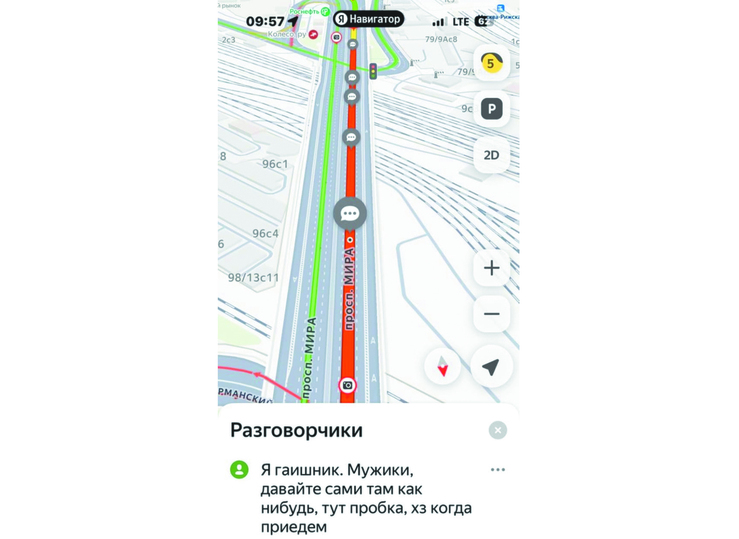A minor accident caused a huge traffic jam: why the capital's Mira Avenue came to a standstill

Last Monday, February 24, Prospekt Mira, the main thoroughfare of northeastern Moscow and the only connection between the capital and the Yaroslavl direction of the Moscow region, stood still for several hours. It stood still: the estimated time of arrival on the navigators simply moved to the right while the cars stood still. If it had been summer, the doors would have slammed, drivers with cigarettes would have appeared outside: what the hell happened again? However, it would have been useless: the cause was an accident far ahead, on the Krestovsky Bridge near Rizhskaya.
The accident happened relatively early in the morning — around 8 a.m., and traffic on the overpass was reported to be back on track three hours later. No details were officially released — other than the fact that five cars collided, which meant the roadway toward the center and the Third Transport Ring was paralyzed. Because, in general, nothing interesting happened.
The Krestovsky overpass, where the city center is already ahead, and you have to slow down for the turn - this is not the Moscow Ring Road with its "large trucks of punishment" and not Kutuzovsky with its street glamour racers. Everything is simpler here: people change lanes, some for the turn, some straight ahead, trying to pass each other and at the same time not to drive onto the route lane markings. Here someone once again miscalculated. Or maybe he was looking at his phone (navigator again?). And there is a pile-up: a second person hit, a third, a fourth... Who and to whom will pay, in short, the court will determine.
But this accident happened near the Third Transport Ring, near the Rizhsky railway station, in the city center by today's standards. And Prospekt Mira and Yaroslavka were in a standstill from Mytishchi to the center - and so thoroughly that many people rushing to work were not saved even by the usual half an hour reserved just in case. And let the accident be an accident or the negligence of a specific driver, let it be so. But the fact that it caused a collapse on the city's most important thoroughfare is not an accident. It is something, forgive the expression, systemic.
Let's bend our fingers. Here's the first thing: the roadway was not cleared of damaged cars immediately (although they should have, in order to restore the traffic capacity, right in about fifteen minutes, no more). Why? Because insurance companies still require accidents to be recorded by the police or accident commissioners, otherwise there are very likely to be problems with payments. The European protocol exists, of course, but it does not work if the damage is significant. And if the culprit of the accident does not have OSAGO, it also does not work.

And by the way, even if the participants in an accident really want to clear the roadway, it may be impossible: parking along the side of the road is usually prohibited or paid. What can you do? This is a huge problem - traffic organizers rarely think about the fact that a car can stall, and where to put it off the road then? Oh, well, yes, this is the driver's problem... But seeing such huge traffic jams, you can't help but agree: this can affect anyone.
And even this would not be a problem if the traffic police patrol had arrived immediately to register the accident. But this is also impossible in the current conditions, unlike at least Moscow 10-15 years ago. After all, there are almost no traffic police "headquarters" in the city center now, and from the Moscow Ring Road you will have to drive through the same traffic jam (after all, there are barriers! The traffic police car has the right to drive in the oncoming lane, but no one will take such a risk).
Let's add to this incendiary cocktail the total telephonization of drivers. Who, being in a traffic jam, feverishly search for detour routes (risking, driving with peripheral vision, to crash into the bumper of a fellow driver in misfortune driving in front). And having reached "that very" place of the accident, they immediately start filming content for social networks. We need to tell the world why we are stuck... And this is a guaranteed reduction in speed in a traffic jam and the risk of joining the ranks of accident participants.
Each of these factors seems to be justified. Well, indeed, insurance companies need to fight fraud, the traffic police are cutting staff and budgets for the common good, and in a traffic jam, there really is nothing to do except play with your smartphone. But when these simple things come together, and the clock shows the best time to go to work and school... Then this sad combo occurs. Or bingo. In short, the stars aligned, and no one seemed to have enough.
By the way, the dedicated lanes were also temporarily switched off due to this accident, and the buses stood in the traffic jam like sweet little ones on equal terms with private cars and taxis. One can't help but sigh about the tram line that existed right on the Krestovsky Bridge - it was physically impossible to get onto it, so the trams would have driven past the traffic jams.
Published in the newspaper "Moskovsky Komsomolets" No. 29469 of February 25, 2025
Newspaper headline: How to plug Moscow with a banal traffic jam
mk.ru






